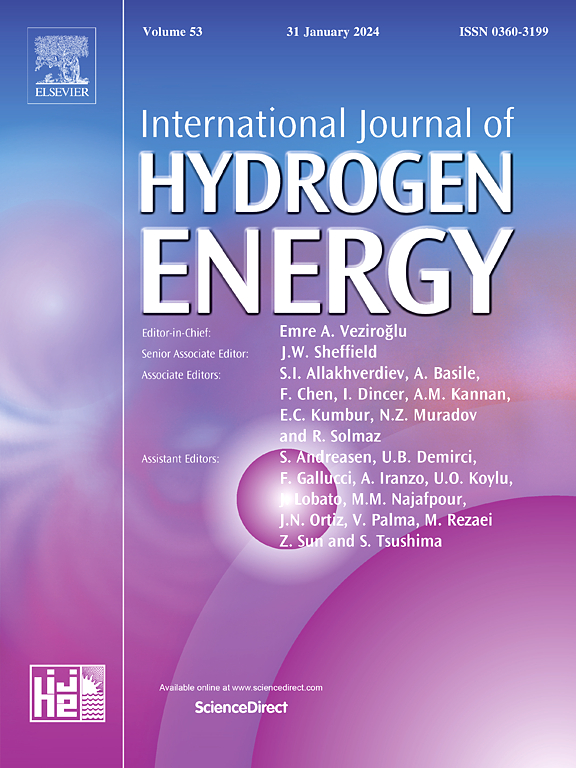用于储氢的聚合物水凝胶:综述
IF 8.1
2区 工程技术
Q1 CHEMISTRY, PHYSICAL
引用次数: 0
摘要
氢被广泛认为是一种绿色和可再生能源载体,对于向可持续能源系统过渡至关重要。传统的储氢方法,如压缩气体、金属氢化物和金属有机框架(mof),提供高存储密度,但通常与安全问题、高能量要求和有限的实用性有关。相比之下,聚合物水凝胶由于其可调节的孔隙度、高吸水性和可逆官能团,提供了一个多功能的储氢平台。本文综述了用于储氢的水凝胶的设计、合成和功能化方面的最新进展,重点介绍了物理吸附、化学吸附和氢夹持等关键机制。重要的是,水凝胶在温和条件下促进可逆的氢吸收和释放,使其成为集成到灵活和智能能源设备中的有希望的候选者。纳米复合水凝胶、刺激响应系统和金属水凝胶杂交体的最新进展进一步提高了存储能力和控制能力。尽管聚合物水凝胶目前的重量氢容量低于mof或金属氢化物,但它们具有优越的可加工性、安全性、可扩展性和多功能性。这些优点使它们成为未来固定式和便携式储氢系统中非常有前途的材料。本文章由计算机程序翻译,如有差异,请以英文原文为准。

Polymeric Hydrogels for Hydrogen (H2) Storage: A Comprehensive Review
Hydrogen is widely recognized as a green and renewable energy carrier that is essential for the transition to sustainable energy systems. Traditional hydrogen storage methods, such as compressed gas, metal hydrides, and metal-organic frameworks (MOFs), offer high storage densities but are often associated with safety concerns, high energy requirements, and limited practical applicability. In contrast, polymeric hydrogels present a versatile platform for hydrogen storage due to their tunable porosity, high water uptake, and reversible functional groups. This review highlights recent advances in the design, synthesis, and functionalization of hydrogels for hydrogen storage, focusing on key mechanisms such as physisorption, chemisorption, and hydrogen entrapment. Importantly, hydrogels facilitate reversible hydrogen uptake and release under mild conditions, making them promising candidates for integration into flexible and smart energy devices. Recent progress in nanocomposite hydrogels, stimulus-responsive systems, and metal–hydrogel hybrids has further improved storage capacity and control. Although their current gravimetric hydrogen capacity is lower than that of MOFs or metal hydrides, polymeric hydrogels offer superior processability, safety, scalability, and multifunctionality. These advantages position them as highly promising materials for future hydrogen storage applications in both stationary and portable systems.
求助全文
通过发布文献求助,成功后即可免费获取论文全文。
去求助
来源期刊

International Journal of Hydrogen Energy
工程技术-环境科学
CiteScore
13.50
自引率
25.00%
发文量
3502
审稿时长
60 days
期刊介绍:
The objective of the International Journal of Hydrogen Energy is to facilitate the exchange of new ideas, technological advancements, and research findings in the field of Hydrogen Energy among scientists and engineers worldwide. This journal showcases original research, both analytical and experimental, covering various aspects of Hydrogen Energy. These include production, storage, transmission, utilization, enabling technologies, environmental impact, economic considerations, and global perspectives on hydrogen and its carriers such as NH3, CH4, alcohols, etc.
The utilization aspect encompasses various methods such as thermochemical (combustion), photochemical, electrochemical (fuel cells), and nuclear conversion of hydrogen, hydrogen isotopes, and hydrogen carriers into thermal, mechanical, and electrical energies. The applications of these energies can be found in transportation (including aerospace), industrial, commercial, and residential sectors.
 求助内容:
求助内容: 应助结果提醒方式:
应助结果提醒方式:


